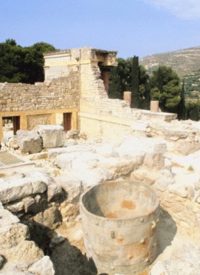
Cathy Gere’s new book, Knossos and the Prophets of Modernism, is of profound significance because it offers the reader an opportunity to examine the manner in which modern and post-modern ideological constructions have hijacked the archaeological study of ancient Crete in the service of various agendas.
One of the hallmarks of postmodernism has been the propensity of the scholars of our age to “deconstruct” past ages; in Gere’s insightful analysis, the process is reversed: The phantasmagoric 20th-century reconstructions of ancient Crete are exploded for their dishonest handling of an unchanging past. Epimenides’ charge against the Cretans (echoed by St. Paul) that the Cretans are all liars may be true, but their lies are small compared to those which nihilists, pacifists, feminists, afrocentrists, and others have told in their name.
Gere’s book centers on the work of English archaeologist Arthur Evans and his purportedly highly selective reimagining of ancient Crete, centering on the Palace of Knossos. The story is one part Heinrich Schliemann, and one part Friedrich Nietzsche, the merger of self-promotion and the madness of the nihilist ideology. In Gere’s words, “Evans embodied all the contradictions of modernism…. Modernist Knossos ties together fascism, feminism, and pacifism; it appears in experimental literature and psychoanalysis; it unites Nietzsche and Freud, James Joyce and Giorgio de Chirico. Certain twentieth-century poets — Hilda Doolittle, Robert Graves — cannot be properly understood without knowing the Cretan archaeology through which they worked out their oracular neopaganism.”
In Gere’s assessment, Evans’ efforts were fundamentally an expression of “the theological crisis of modernism — the death of the Christian God and the accompanying search for an alternative account of human origins.” What emerges is the fact that such an efforts are essentially an attempt to replace the Truth with various lies. The Knossos that emerges from the mind of Evans (and others) is not the historical reality, but an effort to establish a mythological foundation for a whole series of post-/anti-Christian worldviews.
The Schliemann-esque element of Evans’ Crete is precisely the effort to establish a “respectable” Greek origin for an alternative history; “Partly as a result of Schliemann’s spectacular discoveries and his knack for publicity, the Iliad began to assume a new significance as an alternative, pagan origin story for Western civilization. The warrior ethic of the Homeric poems resonated with the social Darwinism and nationalism that was beginning to define post-Christian Europe, and the archaeology of Greek myth took on a futuristic cast.” What Schliemann did for Troy, Evans did for Crete; the image this reader was left with after reading Gere’s account is that modern archaeology in the hands of certain individuals became a new Trojan Horse, smuggling in hostile ideologies bent on destruction under the guise of peaceful “science.” Even Evans’ dig at Knossos became an experiment in political correctness, attempting to shape it into a “site of Christian-Muslim reconciliation” even as he “suppressed the evidence he had already amassed for Minoan military installations and set about resurrecting Bronze Age Crete as an unfortified idyll in the best British style.” The falsification of Cretan history thus begun with the purpose of creating a more peaceful past, the myth began to grow with the telling:
In the immediate aftermath of the Great War, ancient Crete was recreated in the image of a decadent civilization devoured by its own weakness. As the Second World War loomed ever nearer, the Minoans assumed the shape of a ghostly ancient idyll, the very image of Ariadne’s dancing floor on Achilles’ shield. By the time the bombs were raining down on London, Crete had become the archetype of a lost pacifist paradise.
Gere documents the increasingly surreal reinterpretation of Knossos; Knossos and the Prophets of Modernism is a powerful account of the willingness of modern and post-modern man to selectively reinterpret past events while wrapped in scientism’s mantle of purported infallibility. The result, in Gere’s account, is an almost cartoonish Crete that would probably have been utterly unbelievable if unveiled in its full absurdity at the beginning, but which somehow became more believable in the flow of other events of the 20th century. In Gere’s words,
In the 1950s ancient Crete was reinvented as a beatnik Eden of creative spontaneity and existential joy. At the end of the next decade, these neo-Dionysian Minoans were reborn as the exemplary peaceniks of the ancient world, before emerging from their hippie haven to star in an outrageous feminist fable about the matriarchal beginnings of culture. As the cold war arms race escalated, this feminist Eden was retooled for the nuclear age, reenacted by lesbian antinuclear activists as an embattled refuge of Amazonian eco-warriors. At the same time the Afrocentric interpretation of matriarchal, peaceful Minoan Crete was revived to stir up unending controversy in the groves of academe.
In scholarly circles, meanwhile, Minoan archaeologists began gradually to dismantle the last vestiges of Evans’s pacifism, seizing the headlines at the beginning of the 1980s with a series of finds suggesting that the Minoans practiced human sacrifice and cannibalism. By the end of the millennium, the story of modernist Knossos had come full circle.
Thus, in the assessment of the author, what began as a tragedy ended as a farce. According to Gere, “The rules of evidence were sacrificed on the altar of prophetic self-aggrandizement.” Thus, in a sense Knossos is a microcosm of the farcical end of the Modern Age. For all of the post-modern yammering about “narratives” (build on the assumption that nothing is actually true; all that is constructed are plausible stories), facts continue to prove themselves to be rather stubborn things. The implausibility of the views of Nietzsche, Freud, Marx, Darwin, and the rest of the gaggle of modernity’s mythologists is increasingly obvious. In Gere’s words, “There is no escaping the fact that we read the human past to understand the present, and then interpret it in the light of the future that we fear or desire.” Such an acknowledgement unveils the farce for what it is, and lays bare the darkness of the dreams of modernity.
Knossos and the Prophets of Modernism, by Cathy Gere, Chicago and London: The University of Chicago Press, 2009, 277 pages.
Photo of the remains of the Palace at Knossos: Photos.com



